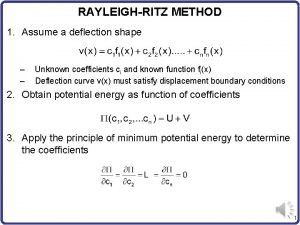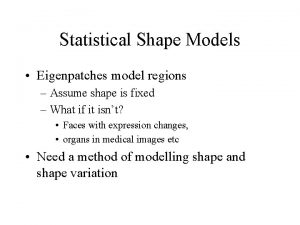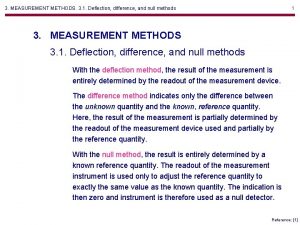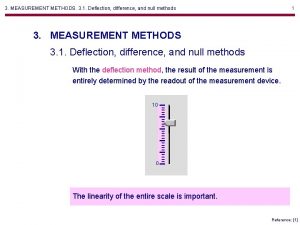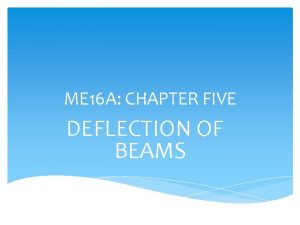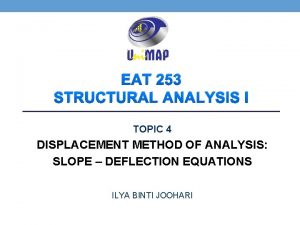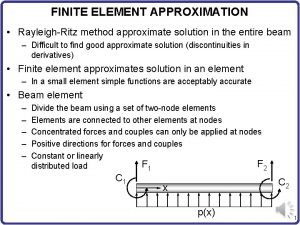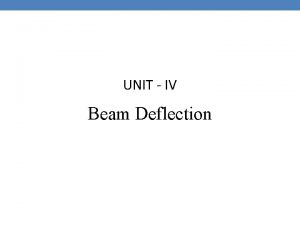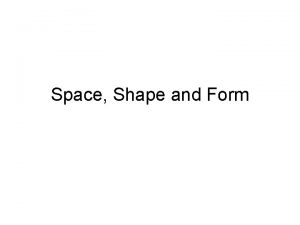RAYLEIGHRITZ METHOD 1 Assume a deflection shape Unknown










- Slides: 10

RAYLEIGH-RITZ METHOD 1. Assume a deflection shape – – Unknown coefficients ci and known function fi(x) Deflection curve v(x) must satisfy displacement boundary conditions 2. Obtain potential energy as function of coefficients 3. Apply the principle of minimum potential energy to determine the coefficients 1

Application to beam problems • The differential equation for the beam displacement is • For a constant p(x)=p 0, the general solution of this differential equation is • When p(x)=0, the exact solution is a cubic polynomial. • Concentrated forces and couples cause discontinuities, in third and second derivatives, respectively. 2

EXAMPLE – SIMPLY SUPPORTED BEAM • Assumed deflection curve • Strain energy p 0 E, I, L • Potential energy of applied loads (no reaction forces) • Potential energy • PMPE: 3

EXAMPLE – SIMPLY SUPPORTED BEAM cont. • Approximate bending moment and shear force • Exact solutions 4

EXAMPLE – SIMPLY SUPPORTED BEAM cont. • Deflection Error increases • Bending moment • Shear force 5

Quiz-like questions • Calculate the Rayleigh-Ritz approximation to the maximum displacement, bending moment and shear force for a simply supported beam under uniform load, when the displacement is assumed of the form v=Cx(L-x) • Why is the solution with the sine so much better? • The coefficient of x 4 is shown in Slide 2 to be 1/(24 EI). What boundary conditions does one use to calculate the coefficients of the other terms (the cubic polynomial in Slide 2)? • Answers in notes page 6

EXAMPLE – CANTILEVERED BEAM –p 0 • Assumed deflection C E, I, L • Need to satisfy BC F • Strain energy • Potential of loads 7

EXAMPLE – CANTILEVERED BEAM cont. • Derivatives of U: • PMPE: • Data: • Solve for c 1 and c 2: • Deflection curve: • Exact solution: Check exact solution 8

EXAMPLE – CANTILEVERED BEAM cont. • Deflection Error increases • Bending moment • Shear force 9

Quiz like questions • Consider the cantilever beam in the figure • Will a cubic polynomial Ritz solution be exact? • We use the Rayleigh-Ritz method with v=Cx 2. • Compare the exact and approximate shear force. • Compare the exact and approximate tip deflection. • Answers in the notes page 10
 Rayleigh ritz method beam deflection
Rayleigh ritz method beam deflection Minimises
Minimises Slope deflection formula table
Slope deflection formula table Deflection method of measurement examples
Deflection method of measurement examples Null deflection method
Null deflection method Deflection of beams macaulay's method
Deflection of beams macaulay's method Slope deflection method
Slope deflection method Slope deflection method definition
Slope deflection method definition Airfoil nomenclature
Airfoil nomenclature Shape matching and object recognition using shape contexts
Shape matching and object recognition using shape contexts Template matching
Template matching
